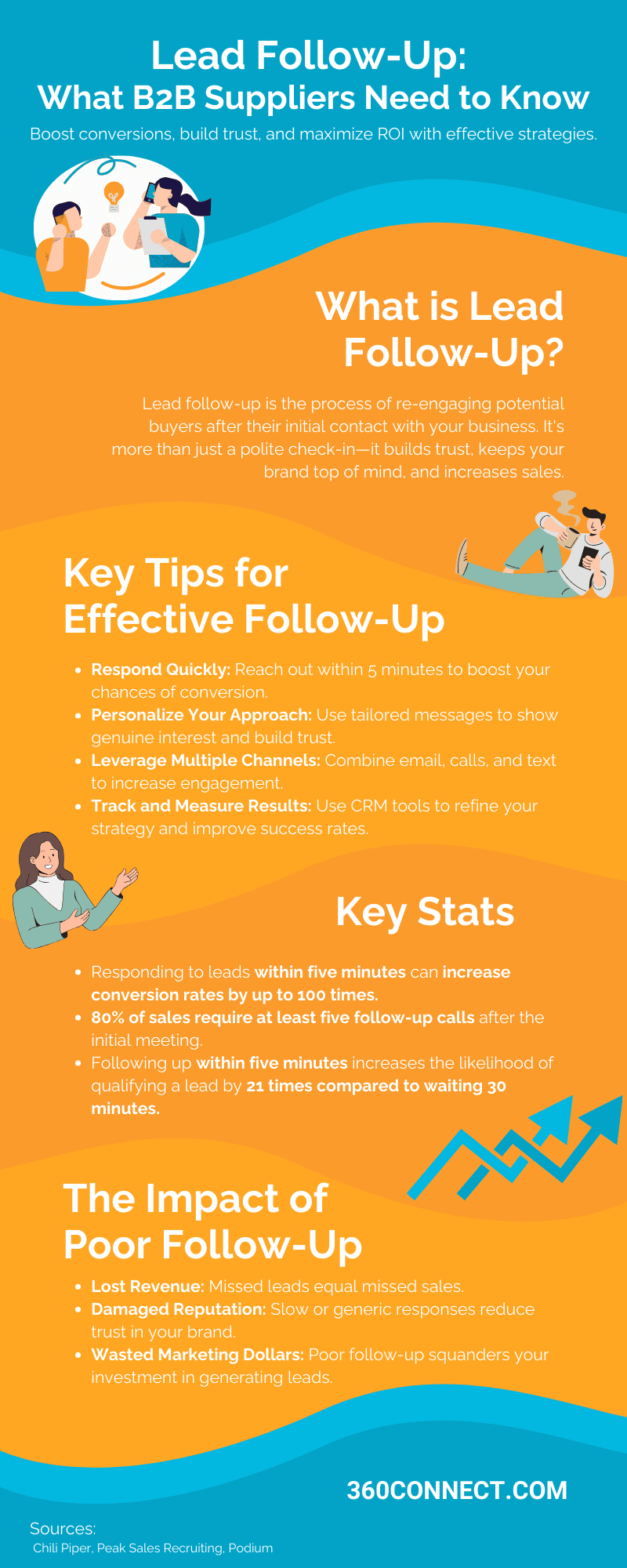A successful sale starts with effective lead follow-up.
When it comes to the sales process, many summarize it as a straightforward cycle: contact, qualify, nurture, and close. While that’s an easy way to think about it, experienced salespeople know there’s much more beneath the surface. One often overlooked but critical aspect is lead follow-up. While it’s tempting to slot follow-up into the “nurture” stage, it’s actually a standalone component—one that requires its own strategy.
In this blog, we’ll define lead follow-up, share actionable tips and strategies to enhance it and discuss the cost of doing it poorly. Let’s jump in!
What is Lead Follow-Up?
Lead follow-up is the process of reconnecting with potential buyers after their initial interaction with your business. Whether it’s responding to a form submission, a phone inquiry, or a meeting at an event, follow-up ensures the lead remains engaged and progresses through your sales funnel. It’s more than just a polite check-in—it’s a structured approach to building trust and moving toward a sale.
A well-defined follow-up process provides clarity for your team, ensuring that every lead receives the attention they deserve. This includes knowing when and how to reach out, tracking responses, and keeping leads engaged until they’re ready to convert. In short, follow-up transforms initial interest into actionable opportunities.

Why Is Lead Follow-Up Important?
Do you enjoy business success? We’re only partially kidding! Effective lead follow-up is vital because it bridges the gap between a lead’s initial interest and their decision to buy. Here’s why it matters:
- Timeliness Drives Conversions: Research shows that following up within five minutes compared to 6 minutes increases the likelihood of conversion by 8x. Essentially, a fast response shows potential buyers that you’re attentive and value their time. Delayed follow-ups, on the other hand, risk losing the lead’s interest or allowing competitors to step in.
- Builds Trust: Consistent follow-up demonstrates reliability, professionalism, and genuine interest in solving the lead’s problem. It’s not just about selling; it’s about showing that you’re a partner they can depend on. Building trust early in the process lays the foundation for a lasting customer relationship.
- Reduces Lead Leakage: Without proper follow-up, leads can slip through the cracks, resulting in wasted marketing dollars. Even the best lead-generation strategies will falter if you fail to nurture and engage those leads effectively. Proper follow-up ensures no opportunity is left untapped.
How Do You Effectively Follow Up With Leads?
So, how do you effectively follow up with leads? Start by creating a structured plan:
- Prioritize Leads: Use lead scoring to identify and focus on the highest-value opportunities. Not all leads are created equal, and your time is valuable. By ranking leads based on factors like engagement level, buying intent, and fit with your offerings, you can direct your efforts where they’ll have the most impact.
- Respond Quickly: Aim to follow up within minutes, not hours. Speed shows enthusiasm and increases conversion rates. A quick response ensures you catch the lead when their interest is at its peak, capitalizing on their motivation to engage with your business.
- Personalize Your Approach: Tailor your messages to the lead’s unique needs and preferences. Generic follow-ups can come across as insincere, while personalized communications show that you’ve taken the time to understand their challenges. Reference specific details from their initial inquiry to demonstrate attentiveness.
- Leverage Multiple Channels: Use email, phone calls, and even text messaging to stay connected. Different leads prefer different communication methods, so diversifying your approach ensures you reach them most effectively. Consistency across channels helps reinforce your message and keeps your business top of mind.
- Track and Measure: Use CRM software to monitor follow-up effectiveness and refine your strategy over time. Tracking allows you to identify what’s working, what’s not, and where you can improve. Data-driven insights help you optimize your approach for better results.
Top 6 Lead Follow-Up Tips
- Have a Clear Timeline: Don’t leave follow-ups open-ended. Schedule check-ins and stick to them. Setting clear timelines for follow-ups ensures that leads don’t feel forgotten or ignored. For example, if a lead asks for time to consider an offer, schedule a follow-up call or email in a few days to check in on their decision.
- Offer Value: Share insights, case studies, or resources that align with the lead’s needs. Offering value beyond your initial pitch shows leads that you’re invested in their success. Whether it’s a relevant industry report or a how-to guide, providing helpful resources keeps the conversation moving forward.
- Ask Questions: Engage leads by asking about their pain points or business goals. Open-ended questions encourage leads to share more about their challenges, giving you the information you need to position your solution effectively. For example, ask, “What’s the biggest challenge you’re facing right now?”
- Be Persistent but Respectful: Follow up multiple times without being overly aggressive. Persistence is key, but it’s important to balance it with respect for the lead’s time. A good rule of thumb is to space out follow-ups and adjust your tone based on their responses.
- Use Automation Wisely: Automate initial follow-ups but personalize subsequent interactions. Automation can save time and ensure no lead is overlooked, but overly generic messages can be a turn-off. Use automation for reminders and updates, while reserving personal touches for deeper engagement.
- Know When to Let Go: Recognize when a lead is no longer viable and focus your energy elsewhere. Not every lead will convert, and that’s okay. Knowing when to move on allows you to dedicate your resources to more promising opportunities, improving your overall efficiency.
The Advantages of Effective Lead Follow-Up
You have the tips, but what exactly are the benefits of effective lead follow-up?
- Higher Conversion Rates: Timely and consistent follow-up can significantly increase your close rate. Leads that are nurtured with care are more likely to trust your business and move forward with a purchase. Every follow-up is an opportunity to address concerns and reinforce your value.
- Improved Customer Relationships: Regular communication fosters trust and builds long-term loyalty. When leads see that you’re attentive and reliable, they’re more likely to view your business as a partner rather than just a vendor. Strong relationships lead to repeat business and referrals.
- Better ROI: Maximizing lead potential means getting the most out of your marketing investment. Effective follow-up ensures that every dollar spent on generating leads translates into meaningful opportunities, boosting your overall return on investment.
What is Poor Lead Follow-Up?
Poor lead follow-up, as the name implies, is when you do a bad job of following up with leads. How does this look? Well, it can take on many forms. It might mean ignoring a lead after they’ve reached out, sending overly generic or irrelevant responses, or worse, overwhelming them with aggressive and frequent communication that comes across as pushy.
These are all signs of a poor strategy—or perhaps no strategy at all. It’s important to remember that leads are potential customers, and how you handle them during the follow-up phase often determines whether they convert or walk away.
This is the moment where you either build trust or lose credibility. If leads feel undervalued or frustrated by your approach, they’ll likely take their business elsewhere—perhaps to your competitor who’s handling their follow-ups better. The ripple effects of poor lead follow-up don’t stop there. They can damage your brand reputation, waste your marketing dollars, and ultimately hurt your bottom line. Recognizing these mistakes and addressing them head-on is key to turning things around.
- Failing to follow up at all. Leads left unattended quickly lose interest.
- Relying solely on generic automation. Automated messages without personalization lack impact.
- Overwhelming leads with aggressive or irrelevant communication. Too much pressure can push leads away.
What Causes Poor Lead Follow-Up?
Poor lead follow-up is usually caused by a combination of factors. Sometimes, it’s because there’s no clear process in place, leaving sales teams unsure of how to handle leads effectively. Other times, sales agents may lack proper training, which makes it harder for them to follow up in a way that engages potential customers.
Another big issue is low-quality leads. When salespeople don’t believe in the value of the leads they’re getting, they’re less motivated to follow up. This lack of confidence can lead to neglect, with leads slipping through the cracks and opportunities being missed. Addressing these problems requires a clear strategy and ensuring that every lead is treated as a valuable prospect.
- No Clear Plan: Without a structured approach, leads often fall through the cracks.
- Low-Quality Leads: Sales agents who doubt the quality of their leads are less motivated to engage.
- Insufficient Training: A lack of skills or tools can hinder effective follow-ups.
What is the Impact of Poor Lead Follow-Up?
- Lost Revenue: Leads not followed up on often result in lost sales.
- Damaged Reputation: Poor communication can harm your brand’s image.
- Wasted Marketing Efforts: Generating leads without following up undermines your marketing spend.
Good vs. Bad Lead Follow-Up
| Good Lead Follow-Up | Bad Lead Follow-Up |
| Personalized messaging that addresses the lead’s specific concerns. Taking the time to tailor your communication shows professionalism and care. | Generic or irrelevant messages. A lack of personalization can make leads feel like just another number. |
| Timely responses that show enthusiasm. Being prompt conveys that the lead’s inquiry is important to you. | Delayed responses that make the lead feel undervalued. Long wait times can lead to frustration and lost opportunities. |
| A structured approach that progresses leads through the funnel. A clear process keeps leads engaged and ensures consistent results. | Sporadic communication that lacks strategy. Inconsistent follow-ups can confuse leads and reduce their confidence in your business. |
How to Fix Low Contact Rates
Lead follow-up is vital, but are you also dealing with low contact rates? How is this related? Well, when follow-up isn’t done effectively, leads can disengage before you even have the chance to connect. Slow response times, impersonal communication, or lack of a solid plan can all play a role in low contact rates. Addressing these issues is key to not only improving follow-up but also ensuring your team reaches and engages more leads.
Let’s dive into some practical steps to turn things around.
- Audit Your Current Process: Identify gaps and bottlenecks in your follow-up strategy. Reviewing your approach helps uncover missed opportunities and areas for improvement. Look for patterns, such as leads dropping off after a specific point.
- Train Your Team: Provide ongoing training to ensure consistent and effective follow-up practices. Equip your team with the tools and knowledge they need to engage leads confidently and professionally.
- Invest in Technology: Use CRM tools to track and manage leads efficiently. The right technology can streamline your process, ensuring no lead is forgotten and every interaction is recorded.
- Create Templates: Develop customizable templates to save time and maintain quality. Templates ensure consistency while allowing room for personalization.
- Test and Refine: Continuously analyze performance metrics and adjust your approach. Testing different methods and tracking results can help you optimize your follow-up strategy over time.
Final Thoughts
Well, there you have it—a complete guide to mastering lead follow-up. By prioritizing this often-overlooked aspect of the sales process, you can turn more leads into loyal customers, maximize your ROI, and build lasting relationships. Remember, effective lead follow-up isn’t just about persistence; it’s about strategy, personalization, and delivering value every step of the way.
Looking for High-Quality Leads?
Ready to boost your sales with verified, quality leads? 360Connect connects businesses like yours with buyers seeking your products and services. Let us help you grow. Join our supplier network today!

